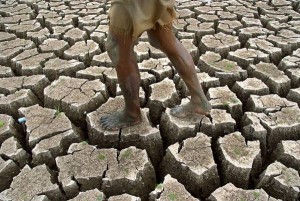Syria showcases effect of climate change
 Can it really happen? Will Middle East and Sahel, band of farmland just south of Sahara, become unlivable?
Can it really happen? Will Middle East and Sahel, band of farmland just south of Sahara, become unlivable?
There’s no let-up in the stream of people making the arduous journey from the Middle East across the Balkans towards Western Europe. But the situation isn’t as acute a crisis as it might soon become due to climate change.
Warnings are rolling in fairly regularly. Frank Bierman, an environmental policy professor at Amsterdam’s VU University, told InsideClimate News: “If we don’t stop climate change, then what we see right now is just the beginning. It has the possibility to turn into a major driver of migration movements.”
US Secretary of State John Kerry warned during a conference in Alaska to prepare for “climate refugees”, saying: “You think migration is a challenge in Europe today because of extremism, wait until you see what happens when there’s an absence of water, an absence of food or one tribe fighting against another for mere survival.”
This is not alarmist claptrap. Three years ago, a World Bank report said that while the planet may warm an extra 4 degrees Celsius, the Middle East and North Africa would heat up 6 degrees.
Five years ago, Bierman led controversial research that warned there may be as many as 200 million climate refugees by 2050 and recommended the creation of an international resettlement fund. An ambitious but poorly funded nest egg of sorts has since been set up by the UN Framework Convention on Climate Change.
Kerry’s views signal the level of anxiety about the situation at the very highest levels of the US government. The Pentagon calls climate change a “threat multiplier”. Hillary Clinton, Kerry’s predecessor at the US State Department and a candidate for president, warns of “water wars”, a lawless, fractious and presumably intensely thirsty time in which countries fight over declining reserves while crops fail, livestock die and populations from the Middle East and North Africa flee desertification and rising sea levels in search of security and sustenance. It would literally be a search for greener pastures.
Can it really happen? Will the Middle East and the Sahel — the band of farmland just south of the Sahara — become unlivable?
Every recent study on the subject is fairly graphic about the effects of a warming planet and the poor husbanding and management of resources on the Middle East and North Africa.
In March, a paper in the Proceedings of the National Academy of Sciences laid out the changes under way in the so-called Fertile Crescent — the arc of productive land that curves from the Arabian Gulf through southern Iraq, Syria, Lebanon, Jordan, Israel and northern Egypt and where the region’s first agricultural communities settled.
“Beginning in the winter of 2006/2007, Syria and the greater Fertile Crescent, where agriculture and animal herding began some 12,000 years ago, experienced the worst three-year drought in the instrumental record,” the researchers wrote, identifying “a long-term drying trend” as well as a “warming trend in the Eastern Mediterranean”.
They were unable to discern natural causes but said the trend seemed “consistent with model studies of the response to increases in greenhouse gases”. And they predicted an increasingly drier and hotter future.
A similar study in the same journal said much the same three years previously but also said the Middle East “has long since exceeded (use of) the water resources necessary to supply its population”.
There’s the rub. The region has unsustainable habits that don’t match its geography. Consider Syria’s terrible drought, which has caused the migration of 1.5 million people to cities and contributed to the conflict that is consuming the country.
As the March PNAS paper said, Bashar Assad’s father, Hafez, made Syria more vulnerable to drought. During his nearly 30-year rule, he initiated policies to increase agricultural production despite growing water scarcity and frequent droughts. This led to the unsustainable depletion of groundwater and the drying of the Khabur river in north-eastern Syria. By 2005, five years into Bashar Assad’s reign, there were attempts to stem the rate at which groundwater was being depleted with a law that required a licence to dig wells.
However, it was enforced half-heartedly, much of the damage had already been done and the drought caused massive crop failure in Syria’s north-eastern breadbasket.
By 2008, after the driest winter on record, wheat production failed, the Syrian government was forced to import and tried to offset the extra expense by cutting fuel and food subsidies. This triggered unrest. The world is feeling the dreadful results.
If any good can come of Syria’s grim story, it is this: It should be a salutary lesson for the region on adapting to and preparing for climate change.

